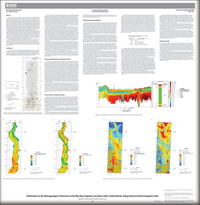Delineation of the hydrogeologic framework of the Big Sioux aquifer near Sioux Falls, South Dakota, using airborne electromagnetic data
Links
- Sheets:
- Data Release: USGS data release - Airborne electromagnetic and magnetic survey data, Big Sioux aquifer, October 2015, Sioux Falls, South Dakota
- Download citation as: RIS | Dublin Core
Abstract
The U.S. Geological Survey, in cooperation with the City of Sioux Falls, South Dakota, began developing a groundwater-flow model of the Big Sioux aquifer in 2014 that will enable the City to make more informed water management decisions, such as delineation of areas of the greatest specific yield, which is crucial for locating municipal wells. Innovative tools are being evaluated as part of this study that can improve the delineation of the hydrogeologic framework of the aquifer for use in development of a groundwater-flow model, and the approach could have transfer value for similar hydrogeologic settings. The first step in developing a groundwater-flow model is determining the hydrogeologic framework (vertical and horizontal extents of the aquifer), which typically is determined by interpreting geologic information from drillers’ logs and surficial geology maps. However, well and borehole data only provide hydrogeologic information for a single location; conversely, nearly continuous geophysical data are collected along flight lines using airborne electromagnetic (AEM) surveys. These electromagnetic data are collected every 3 meters along a flight line (on average) and subsequently can be related to hydrogeologic properties. AEM data, coupled with and constrained by well and borehole data, can substantially improve the accuracy of aquifer hydrogeologic framework delineations and result in better groundwater-flow models.
AEM data were acquired using the Resolve frequency-domain AEM system to map the Big Sioux aquifer in the region of the city of Sioux Falls. The survey acquired more than 870 line-kilometers of AEM data over a total area of about 145 square kilometers, primarily over the flood plain of the Big Sioux River between the cities of Dell Rapids and Sioux Falls. The U.S. Geological Survey inverted the survey data to generate resistivity-depth sections that were used in two-dimensional maps and in three-dimensional volumetric visualizations of the Earth resistivity distribution. Contact lines were drawn using a geographic information system to delineate interpreted geologic stratigraphy. The contact lines were converted to points and then interpolated into a raster surface. The methods used to develop elevation and depth maps of the hydrogeologic framework of the Big Sioux aquifer are described herein.
The final AEM interpreted aquifer thickness ranged from 0 to 31 meters with an average thickness of 12.8 meters. The estimated total volume of the aquifer was 1,060,000,000 cubic meters based on the assumption that the top of the aquifer is the land-surface elevation. A simple calculation of the volume (length times width times height) of a previous delineation of the aquifer estimated the aquifer volume at 378,000,000 cubic meters; thus, the estimation based on AEM data is more than twice the previous estimate. The depth to top of Sioux Quartzite, which ranged in depth from 0 to 90 meters, also was delineated from the AEM data.
Suggested Citation
Valseth, K.J., Delzer, G.C., and Price, C.V., 2018, Delineation of the hydrogeologic framework of the Big Sioux aquifer near Sioux Falls, South Dakota, using airborne electromagnetic data: U.S. Geological Survey Scientific Investigations Map 3393, 2 sheets, https://doi.org/10.3133/sim3393.
ISSN: 2329-132X (online)
Study Area
Table of Contents
- Abstract
- Introduction
- Geology and Hydrogeology of the Big Sioux Aquifer
- Previous Work on the Big Sioux Aquifer
- Airborne Electromagnetic Methods
- References Cited
| Publication type | Report |
|---|---|
| Publication Subtype | USGS Numbered Series |
| Title | Delineation of the hydrogeologic framework of the Big Sioux aquifer near Sioux Falls, South Dakota, using airborne electromagnetic data |
| Series title | Scientific Investigations Map |
| Series number | 3393 |
| DOI | 10.3133/sim3393 |
| Publication Date | March 21, 2018 |
| Year Published | 2018 |
| Language | English |
| Publisher | U.S. Geological Survey |
| Publisher location | Reston, VA |
| Contributing office(s) | Dakota Water Science Center |
| Description | 2 Sheets: 35.0 x 36.0 inches and 26.0 x 26.0 inches; Data Release |
| Country | United States |
| State | South Dakota |
| City | Sioux Falls |
| Other Geospatial | Big Sioux Aquifer |
| Online Only (Y/N) | Y |
| Additional Online Files (Y/N) | Y |


